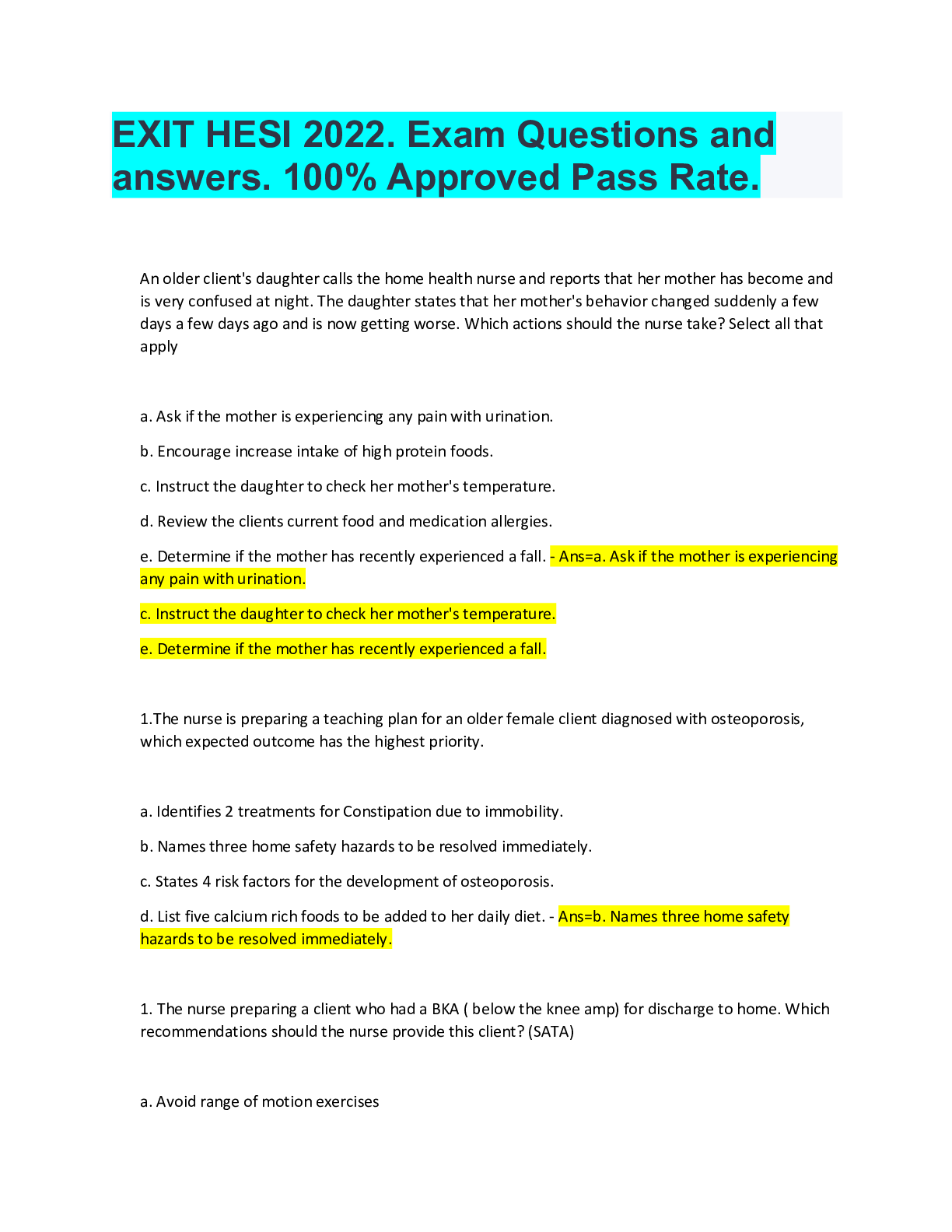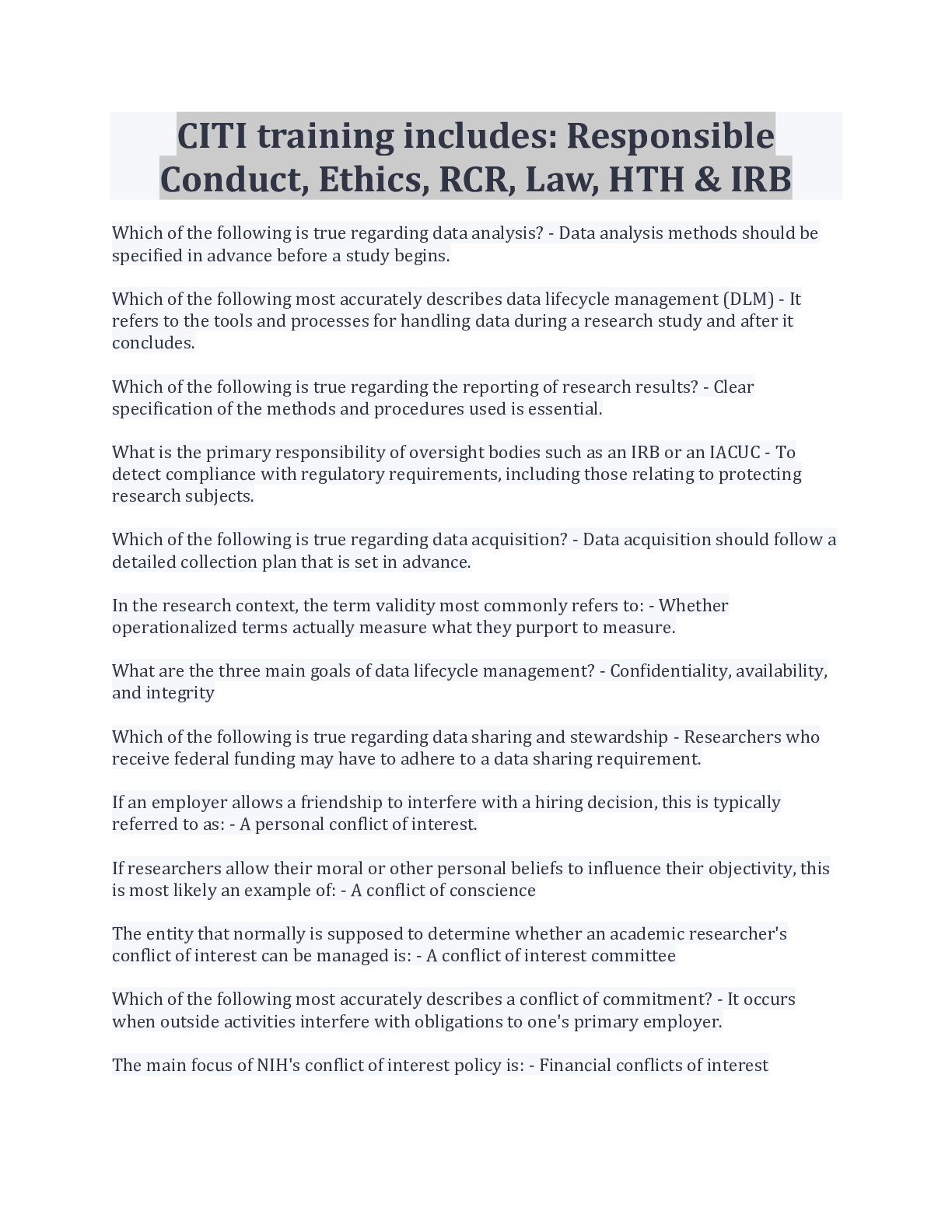Health Care > QUESTIONS & ANSWERS > Psychiatric-Mental Health Nurse Practitioner CertificationMASTERPIECE. ANCC IQ Domains 1-5 Questions (All)
Psychiatric-Mental Health Nurse Practitioner CertificationMASTERPIECE. ANCC IQ Domains 1-5 Questions bank. 100% Approved pass rate. Answered all correctly ; latest updated summer 2022.
Document Content and Description Below
As a PMHNP, you are aware of antipsychotic medication side effects. Which of the following side effects of antipsychotic medications has an insidious, delayed-onset typically 1 to 2 years after initia... tion of the medication? a. Dry mouth b. Tardive dyskinesia c. Sedation d. Weight gain - Ans-B In evaluating a 4-year-old, one would expect which of the following delays in Asperger's Disorder? a. Language development b. Cognitive development c. Motor skills coordination d. Social skills development - Ans-D Which area of the brain has been implicated to modulate pain and can help explain how transcranial magnetic stimulation can help decrease pain? a. Prefrontal cortex b. Insula cortex c. Dorsolateral prefrontal cortex d. Anterior cingulate cortex - Ans-A Which of the following antidepressants is associated with dose-related cardiovascular adverse effects which require adherence to maximum recommended dosing, unless higher doses are deemed appropriate despite risks? a. Citalopram (Celexa) b. Venlafaxine (Effexor) c. Mirtazapine (Remeron) d. Sertraline (Zoloft) - Ans-A Which of the following findings would raise concern in an annual sports exam for a 15-year-old girl? a. Scar tissue from hymenal tear at 11 o'clock (reported biking injury) b. Blood pressure 86/56 c. Height 67 inches, weight 102 pounds d. Pulse 60, respirations 26 - Ans-C A week after raising the dose of risperidone (Risperdal), a patient treated for schizophrenia presents to the clinic with reports of an acute change in mental status, fever, and rigidity. As the treating PMHNP, you know these symptoms are consistent with which of the following? a. Neuroleptic malignant syndrome (NMS) b. Anticholinergic withdrawal syndrome c. Extrapyramidal side effects d. Serotonin syndrome - Ans-A Which of the following statements regarding disulfiram (Antabuse is correct? a. Disulfiram should not be taken for at least 6 hours after drinking alcohol. b. Avoid anything containing alcohol (i.e., vinegar, mouthwash, aftershave, cough medication) while using disulfiram and for 2 weeks after discontinuing. c. A disulfiram-alcohol reaction can occur up to 1 week after discontinuing disulfiram. d. Disulfiram can lower liver function tests so monitoring is necessary. - Ans-B Which mood stabilizer is most associated with a potentially life-threatening rash? a. Divalproex (Depakote) b. Lamotrigine (Lamictal) c. Lithium (Eskalith) d. Carbamazepine (Tegretol) - Ans-B Which of the following statements most accurately reflects the predominant risk factors of antisocial personality disorders? a. Gang affiliation and early substance abuse b. Genetic predisposition of first-degree family member c. Childhood abuse and trauma from domestic violence d. Lower socioeconomic status from single-parent families - Ans-B A 37-year-old patient with schizophrenia is started on a high dose of chlorpromazine (Thorazine). The next day, he complains of lightheadedness after standing up. Vital sign changes reflect a significant decrease in blood pressure and an increase in heart rate. You suspect this is secondary to the alpha 1-adrenergic blockade which is causing a. Orthostatic hypotension b. Dry mouth c. Respiratory depression d. Decreased sweating - Ans-A A 74-year-old female presents for an evaluation. The psychiatric nurse practitioner has the patient complete the mini mental status examination and clock drawing. The patient is unable to correctly draw the face of the clock. Which area of the brain is likely to have a compromised functioning? a. Wernicke's Area b. Corpus Callosum c. Left Hemisphere d. Right hemisphere - Ans-D Your patient comes into the office for her middle of the year appointment. She is diagnosed with Bipolar I disorder. She has been maintained well for the past 3 years on Oxcarbazepine (Trileptal) 900 mg po QHS. Her labs are normal except for a blood sugar of 114 and her hemoglobin A1C is 5.6. She has a normal energy level and states that her mood is stable but complains of excessive urination and thirst. You suspect: a. Possible Diabetes 2 b. Possible hyponatremia c. Possible polydipsia d. Side effects of oxcarbazepine - Ans-D What is a rare but serious side effect of trazodone (Desyrel)? a. Confusion b. Priapism c. Rash d. Tremor - Ans-B When studying pharmacodynamics involving receptors, you know that an inverse agonist produces the following effect: a. Does not fully activate the receptor and causes only limited actions b. Causes the opposite effect of agonist, and causes the receptor to close the ion channel c. Blocks the agonist from opening the channel, and does not activate a biological response d. Activates a biological response, and opens the ion channel. - Ans-B Mr. Smith is a 56-year-old white male who has been successfully treated on Selegiline for over 4 years. Mr. Smith is going in for an elective surgical procedure. Which medication is strictly contraindicated with Selegiline? a. Non-steroidal anti-inflammatory drugs (NSAIDs) b. Meperidine c. Codeine d. Morphine - Ans-B Patty is a 62-year-old white female with Bipolar I Disorder and has been stable for 2 years on valproate and risperidone. She was recently diagnosed with shingles, and her primary care nurse practitioner started her on corticosteroids. As the PMHNP treating Patty, you are concerned that the addition of the corticosteroids may cause a. Neuroleptic Malignant Syndrome b. A hypertensive crisis c. A manic episode d. Stevens-Johnson syndrome - Ans-C Which serotonin receptor antagonism makes an antipsychotic "atypical"? a. 5HT4A b. 5HT1A c. 5HT3A d. 5HT2A - Ans-D What direct-acting dopamine receptor agonist is recommended to be used in the treatment of neuroleptic malignant syndrome (NMS) to help lower the dopamine receptor blockade? a. Benztropine (Cogentin) b. Bromocriptine (Parlodel) c. Trihexyphenidyl (Artane) d. Dantrolene (Dantrium) - Ans-B A 17-year-old female presents to your clinic reporting anhedonia, decreased energy, and hopelessness for the past two years. She denies drinking alcohol, smoking, or using illegal substances. Her physical examination results are within normal limits and she denies suicidal ideations. As the treating psychiatric mental health nurse practitioner, you decide to prescribe her bupropion (Wellbutrin). Of the following, which is contraindication for the use of bupropion? a. Bulimia b. Dysthymia c. Smoking d. Fatigue - Ans-A Which of the following statements reflects current understanding of neurodevelopment and best explains risk-taking behaviors of adolescent males? a. Hormonal flooding, especially testosterone and oxytocin, increase dopamine levels in the brain b. Maturation of the prefrontal cortex continues into mid-20s and early 30s c. Pruning of serotonin circuits in the adolescent brain is associated with increased impulsivity d. Stimulant and substance use impairs judgment and cognitive appraisal. - Ans-B Which of the following statements does not reflect current understanding of neurotransmitter pathways implicated in anxiety disorders? a. Decreasing norepinephrine in the locus coeruleus diminishes symptoms of anxiety. b. Increased levels of CRF in the amygdala, hippocampus and locus coeruleus increases symptoms of anxiety. c. Decreasing GABA in the mesolimbic cortex diminishes symptoms of anxiety. d. Increasing serotonergic activity in the amygdala diminishes symptoms of anxiety. - Ans-C Which of the following findings on MRI and PET scans would be uncommon in individuals with schizophrenia? a. Decreased glutamate and GABA release b. Decreased total brain volume c. Decreased electrical activity in the frontal lobes d. Decreased size of cerebral ventricles - Ans-D Which of the following findings would raise concern in a pre-school wellness exam for a 5-year-old girl? a. Blood pressure 92/52 b. Pulse 102, respirations 30 c. Completed immunizations: MMR, Varicella, DTap, IPV, PCV, Hib, HepB d. Height 43 inches, weight 55 lbs - Ans-D The PMHNP would expect to see which of the following during a physical exam for a patient with bulimia nervosa? a. Obesity b. Tachycardia c. Alopecia areata d. Erosion of dental enamel - Ans-D 1. While treating a 12-year-old boy for ADHD, the PMHNP observes which of the following physical features that raise concerns for genetic evaluation for Fragile X syndrome? a. Small head, short palpebral fissure, inner epicanthal folds b. Café au lait spots on face and arms, neurofibromas c. Long head and ears, short stature, hyperextensible joints d. Obesity, small stature, small hands and feet, hypotonia - Ans-C You are on call for your service. You arrive at the emergency department to find a 22-year-old male patient complaining of having trouble with his eyes. His vitals are stable. He is 5 foot and 7 inches tall; his weight is 140 pounds; his labs are all in the normal range. He states that he has been taking Aripiprazole (Abilify) for the last 2 months for his Bipolar 1 disorder. He had the dose raised to 15 mg po QAM 4 days ago to manage a manic episode. He states that one to three times a day for the past 2 days his eyes will roll upwards for 10 to 15 minutes and he will have trouble seeing until they roll back down. When you examine his eyes, he is able to fully open his eyes but he is not able to focus his eyes on you. His eyes are rolled upwards about 2/3rds of the way towards his upper eyelid. After examination you decide to: a. Discontinue the Aripiprazole and begin the patient on a gradually increasing regimen of Lamotrigine 25 mg 1 po QHS for 1 week. Have him return to his provider for further management of his bipolar disorder. b. Continue the Aripiprazole and give Benztropine Mesylate (Cogentin) 1 mg IM. Have him take Benztropine Mesylate (Cogentin) 1 mg po BID. Have him return to his provider for further management of his bipolar disorder the next day. c. Begin a cross titration downward of the Aripiprazole and upwards of Haloperidol (Haldol). Have him return to his provider for further management of his bipolar disorder. d. Discontinue the Aripiprazole and give Benztropine Mesylate (Cogentin) 1 mg IM. Have him take Benztropine Mesylate 1 mg po BID for 5 days. Have him return to his provider for a different medication for his bipolar disorder the next day. - Ans-D A 24-year-old mother of a 2-year-old child presents to the clinic. Which of the following facial characteristics would lead the psychiatric mental health nurse practitioner to believe the child has fetal alcohol syndrome? a. Large head, thick upper lip, and overdeveloped jaw b. Small head, thin upper lip, and smooth philtrum c. Long nose, large eyelid opening, and developed philtrum d. High nasal bridge, plump midface, and large eyelid opening - Ans-B A client is suffering from schizophrenia. Which of the following would be the appropriate question for the PMHNP to ask when assessing side effects produced by dopamine antagonism in the tuberoinfundibular pathway? a. Are you experiencing breast discharge? Research utilization process - Ans-critique, synthesize, apply, measure Reviewing Evidence before Translation - Ans-1. Review several randomized control studies of the same results 2. Review several non randomized control studies of the same result -Single randomized controlled trials or non randomized trials are level 2 evidence as far as intervention effectiveness Domains of Implementing Evidence Based Research - Ans--current research evidence -availability of healthcare resources -clinician's expertise -patient's clinical status, circumstances, and preferences Generalizability of findings is not relevant Olanzapine (Zyprexa) + Fluoxetine (Prozac) = Symbyax - Ans-FDA approved for treatment of bipolar depression Accupuncture with Medication for Depression - Ans-Proven effective in combination; support patient in exploring treatment option if patient requests Tx for Alcohol withdrawal without Hepatic Impairment - Ans-Long acting Benzos: -Librium -Diazepam Clozapine (Clozaril) - Ans-only medication effective for reducing SI in suicidal schizophrenic patients Manualized Group Intervention w/ Motivational Enhancement - Ans-Evidence based intervention proven to reduce co-morbid substance abuse in patients with schizophrenia Lurasidone (Latuda) - Ans--Needs to be taken with 360 calorie-meal for full absorption -only 1/2 gets absorbed if you don't have a 360 calorie-meal Turkey - Ans-Contains tryptophan - promotes sleep despite being high in protein High protein food vs High Carb food - Ans-High protein promotes wakefulness (except turkey because of tryptophan) High carb promotes sleepiness When working with clients who have poor affect regulation and limited response flexibility, a therapist should maintain being - Ans-Mindful Reflective Intentional Erikson's Stages of Development - Ans-0-1 Trust vs Mistrust 1-3 Autonomy vs Shame & Doubt 3-6 Initiative Vs Guilt 6-12 Industry vs Inferiority 12-20 Identity vs Role Confusion 20-35 Intimacy vs Isolation 35-65 Generativity vs Stagnation 65 above Integrity vs Despair Reminiscence Therapy - Ans-Thinking about or relating past experiences Maintains: Self-esteem Stimulate thinking/cognitive function Support natural healing process of life review Does NOT reduce wandering behavior What does the Ego do with the Id? - Ans-The Ego Monitors the Id I think and evaluate What does overly confrontational leadership do? - Ans-Provokes hostile and increasingly defensive interactions Why are attachment relationships between infant and mother or any primary caregiver important? - Ans-attachment to significant relationships facilitates self-regulation of emotions Self-regulation of emotions develops from childhood through adolescence Family Life Cycle "Empty Nest" - Ans--When kids are grown and leaving house, mothers usually feel sad, regretful, fatigued Normal tasks include: >Renegotiation of marital system as a dyad >Development of adult-adult relationships >Realignment of relationships between in laws >Dealing with disabilities and death of parents/grandparents Important Intervention in children who discuss parents' arguments and fights - Ans-Dispelling their thought that they are the cause of parental fights by facilitating sharing of how the incident made them feel and recognizing its not their fault. Avoid discussion of details of the parents' fight in young children Priority Intervention when a client experiences a flashback - Ans-Grounding Techniques-Bring the person's level of consciousness to the immediate therapeutic environment by rubbing upholstery chair, stomping one's feet, deep breathing, eye contact, walking outside, well lit room, supportive self-talk Speak in the present so traumati 1. A 37-year-old male with schizophrenia, paranoid type, lives in supervised housing and is followed by the Assertive Community Treatment Team through a Community Mental health Center (CMHC) where the PMHNP notes that he has refused to see any PCP during the past several years despite efforts by case managers to accompany him to medical visits. He ahs gained 30 pounds in past three years on clozapine since his last inpatient hospitalization. His WBC and ANC counts remain within normal limits, but he ahs elevated cholesterol, lipids, and A1C levels. What is the most appropriate intervention to facilitate care for this patient? - Advise the patient that needs to see a PCP to treat his elevated cholesterol and blood sugar levels and ask what has prevented him from seeing a PCP when referred in past. - Advise the patient that he needs to see a PCP to treat his elevated cholesterol and blood sugar levels and ask his preference for referral to one of the CMHC's affiliated PCPs. - Explain the health risks of his elevated cholesterol and blood sugar levels and that he may eventually have to be hospitalized for medical treatment because this is a serious problem. - Explain the health risks of his elevated cholesterol and blood sugar levels and separately ask the patient and case manager what has prevented him form seeing PCP when referred in past. - Ans-- Explain the health risks of his elevated cholesterol and blood sugar levels and separately ask the patient and case manager what has prevented him form seeing PCP when referred in past. Rationale: Basic explanation of the health risks of the elevated cholesterol and blood sugar levels, individual exploration of his fears and reasons for not seeing a PCP, and separate exploration of the case manager's observations and understanding of the patient's avoidance behavior is the most likely approach to facilitate the patient's understanding and consent to this coordination of care. Coercive approaches such as invoking fear of medical hospitalization are not warranted or ethically appropriate. Veracity is an ethical principle underlying the idea of trust and fiduciary relationships. Veracity or truthfulness in giving patients information about health care needs facilitates autonomous choice and enhances patient decision-making. [Show More]
Last updated: 1 year ago
Preview 1 out of 80 pages
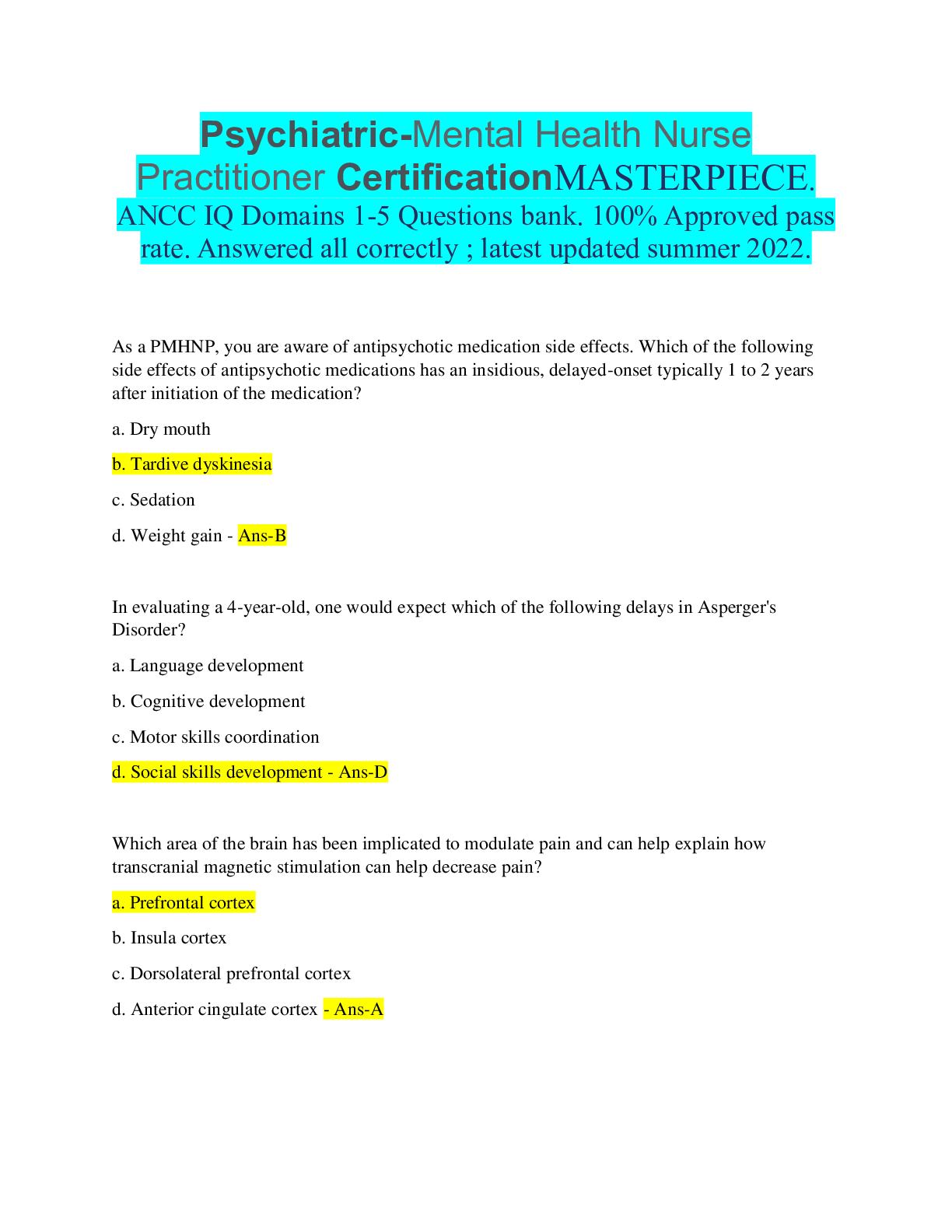
Reviews( 0 )
Document information
Connected school, study & course
About the document
Uploaded On
Jun 11, 2022
Number of pages
80
Written in
Additional information
This document has been written for:
Uploaded
Jun 11, 2022
Downloads
0
Views
94

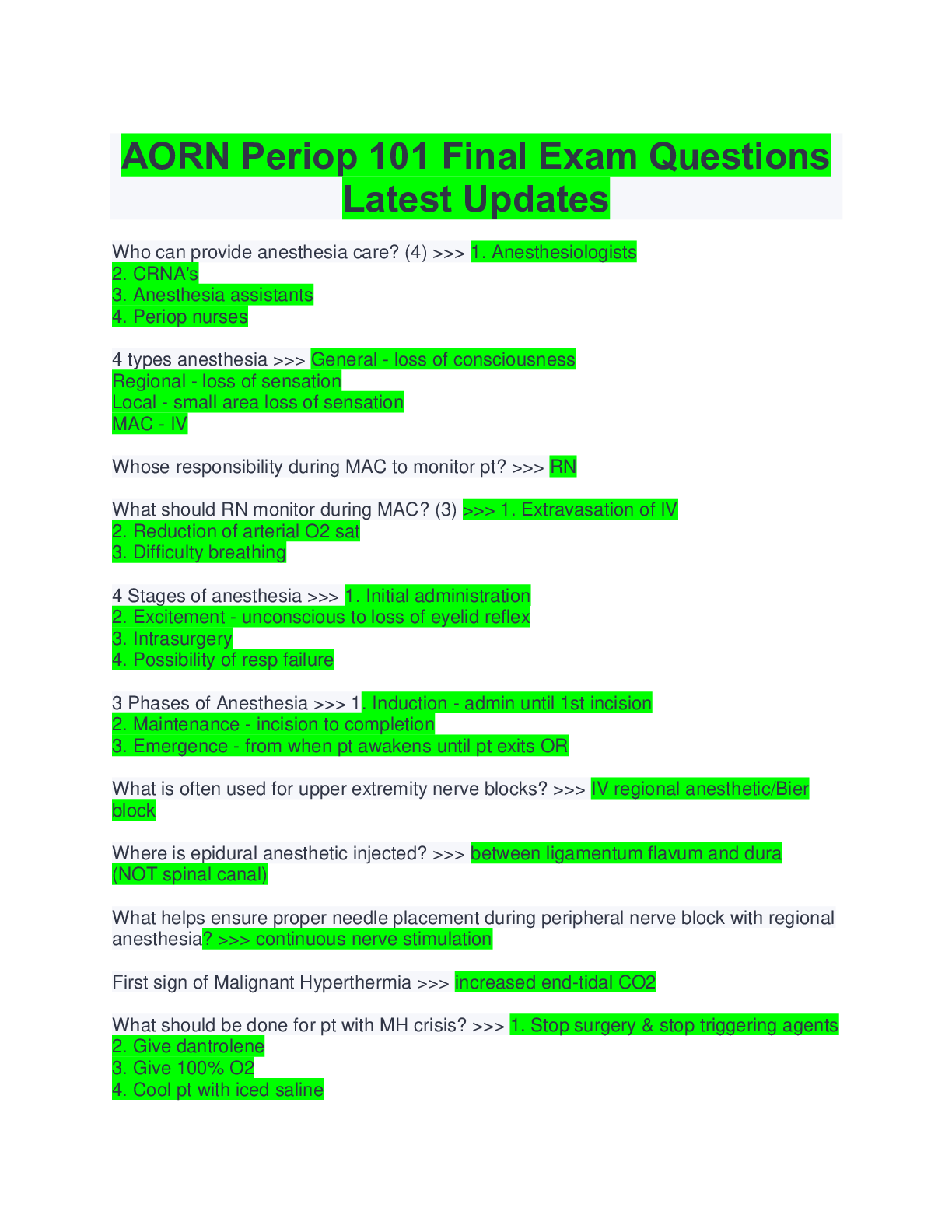






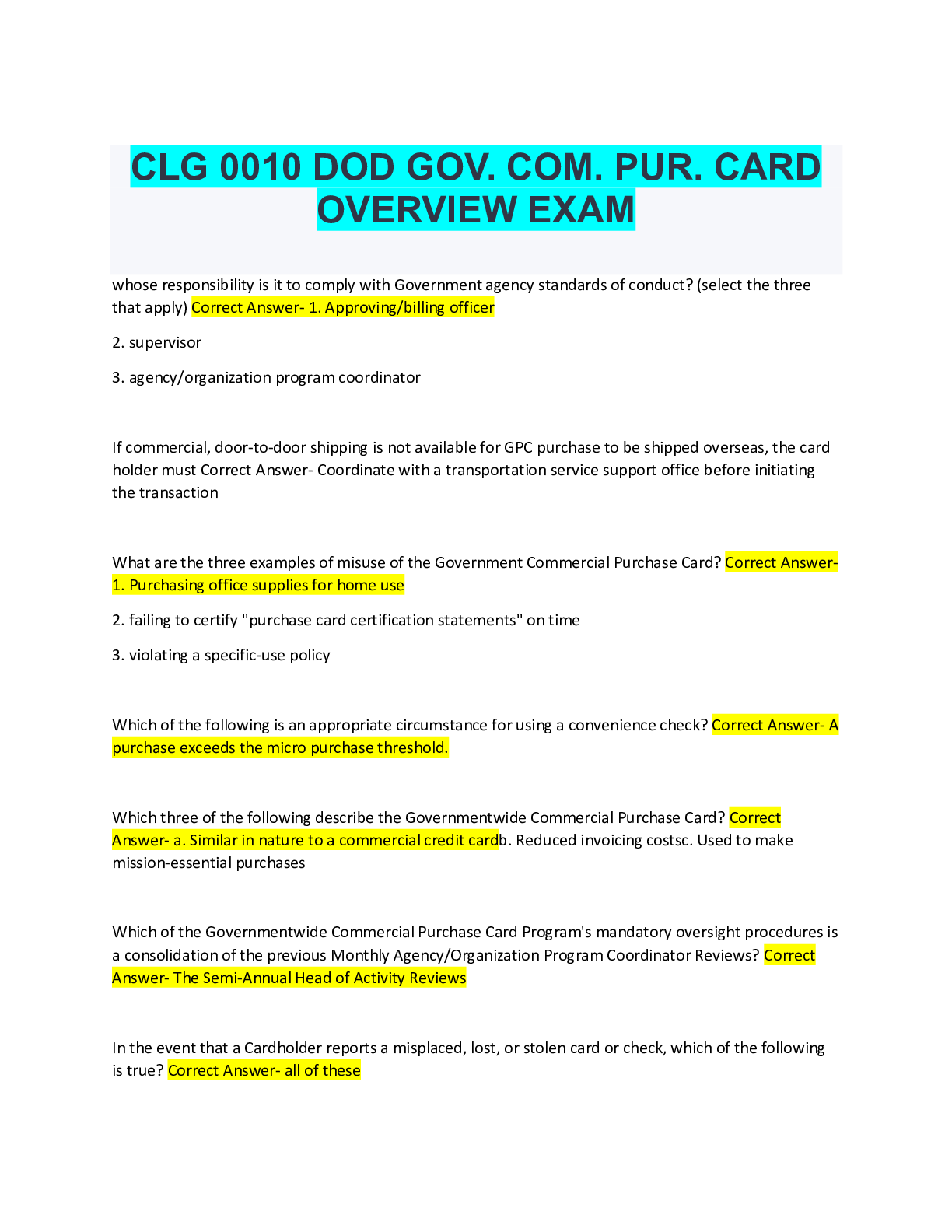


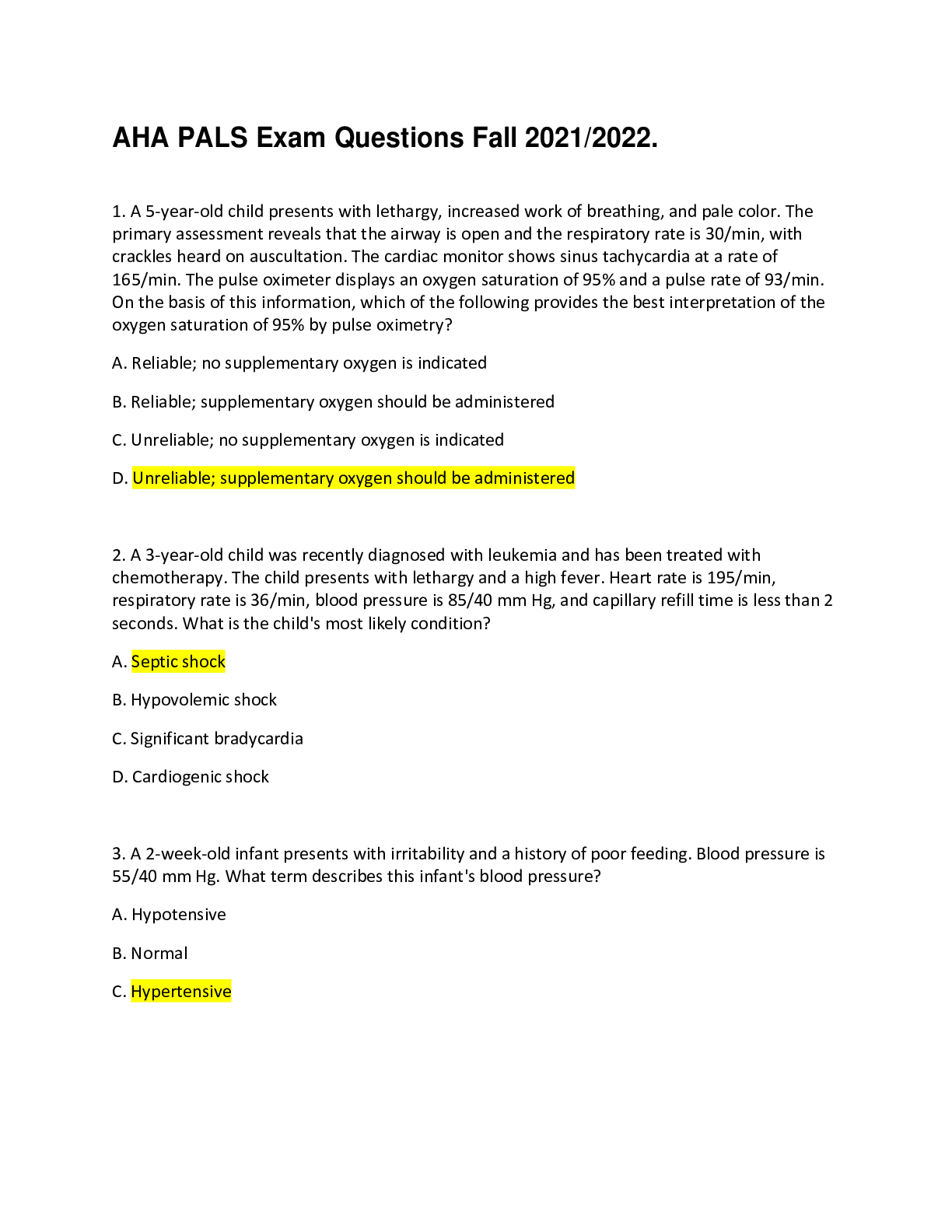

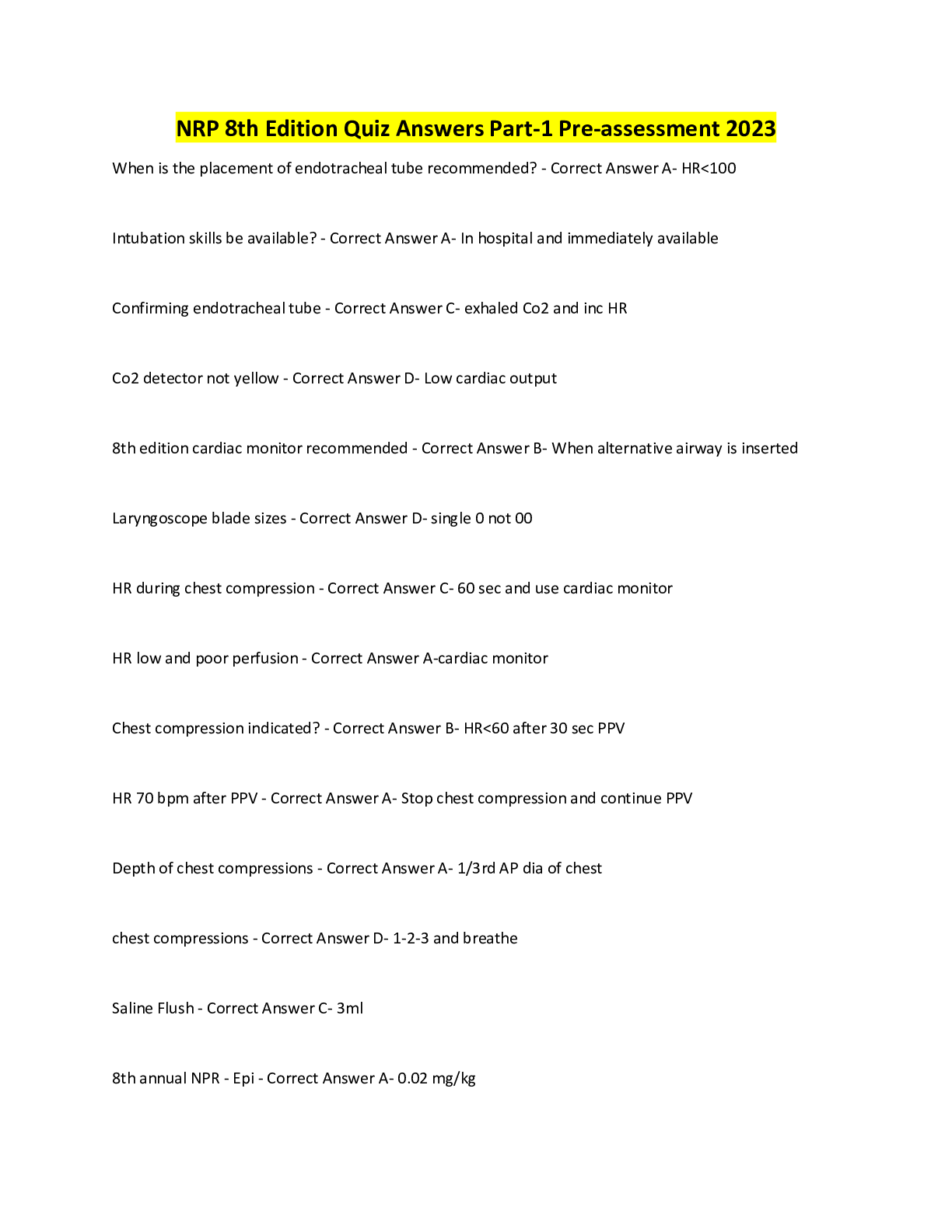

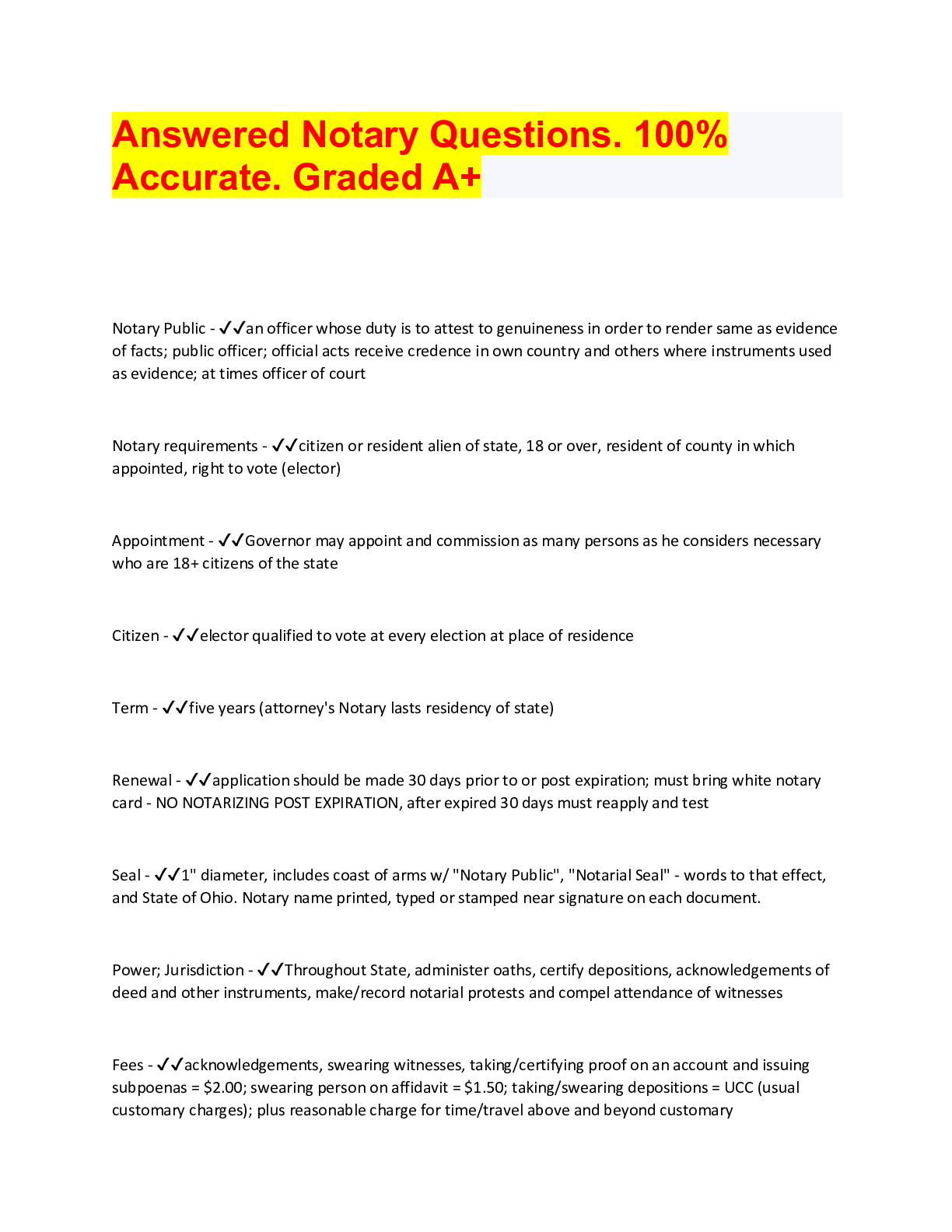


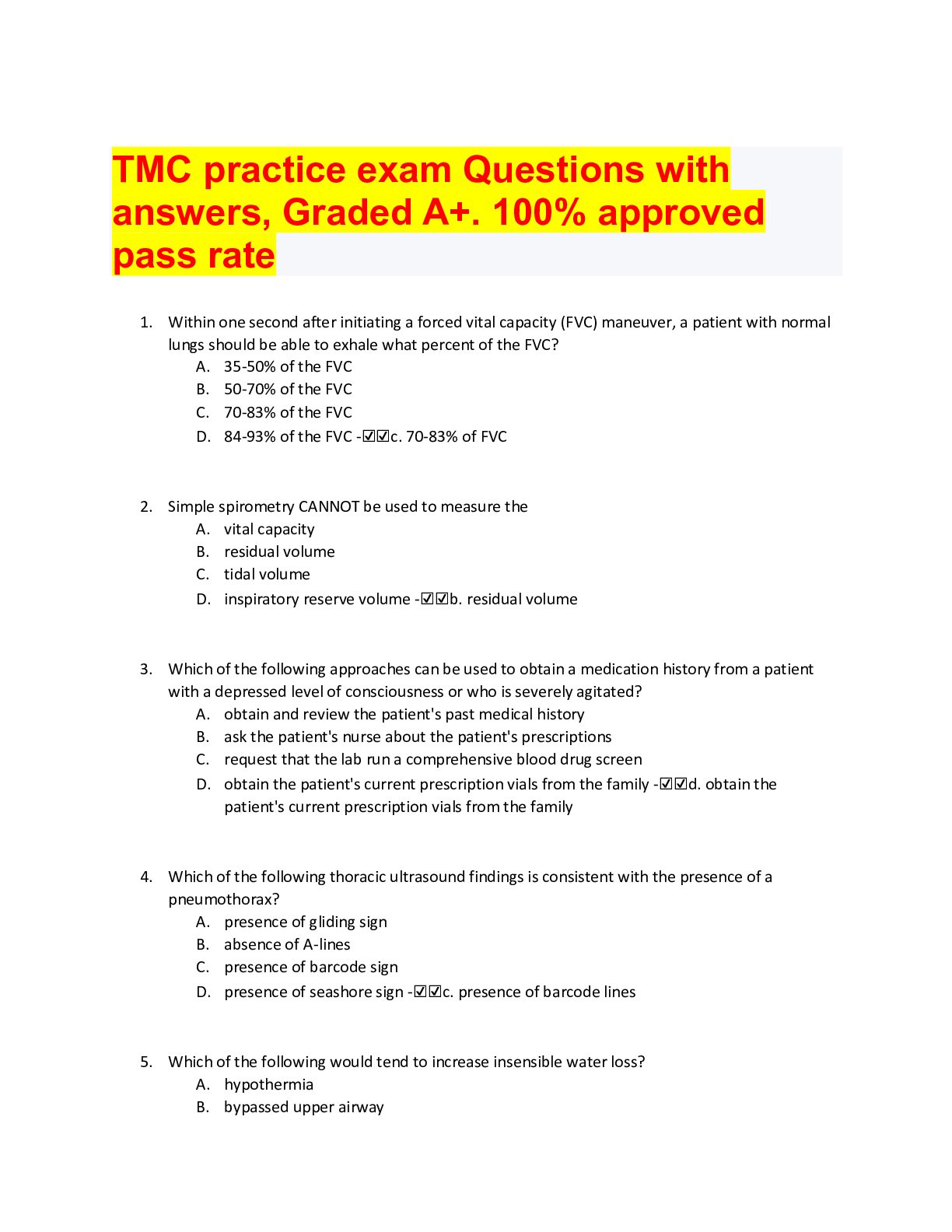
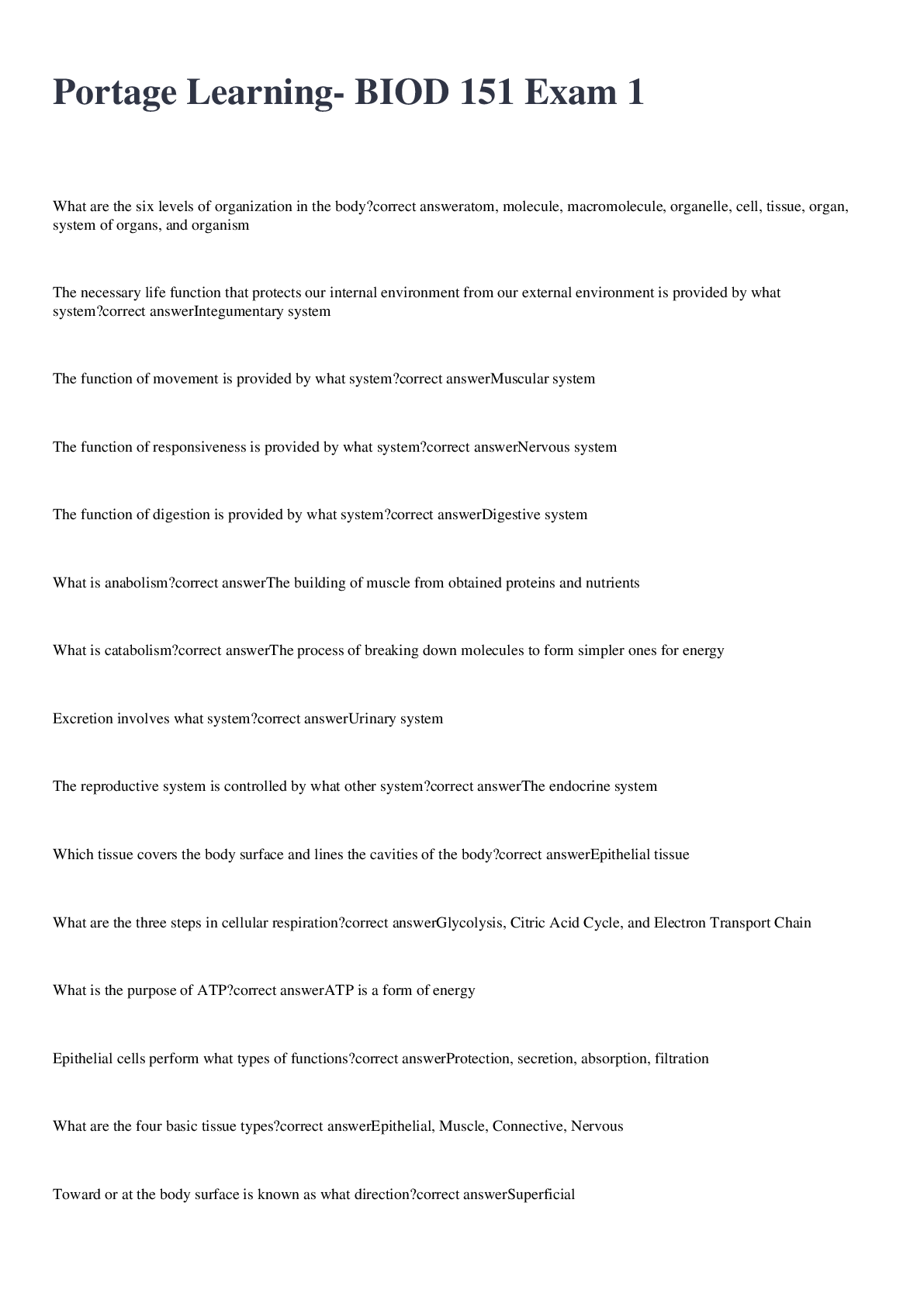
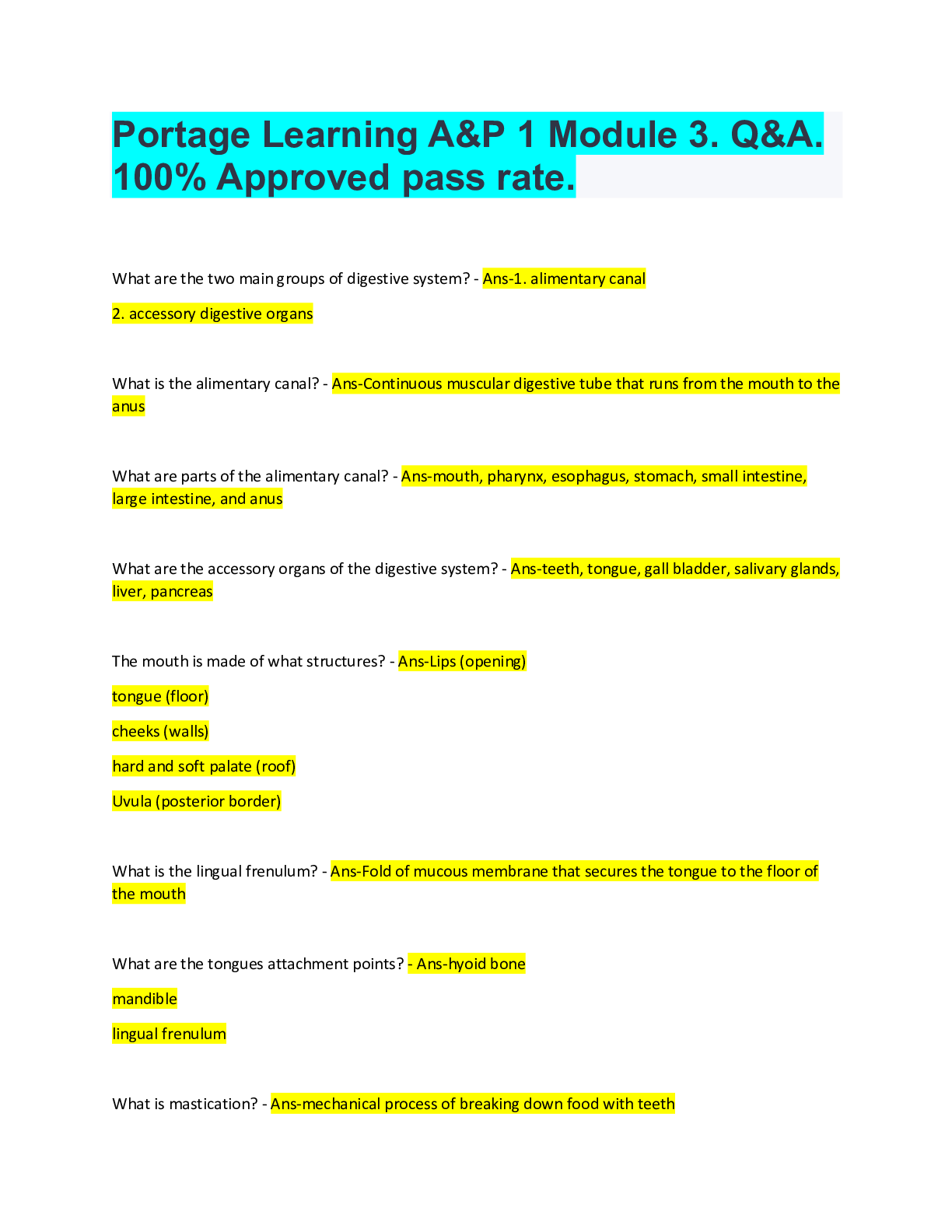
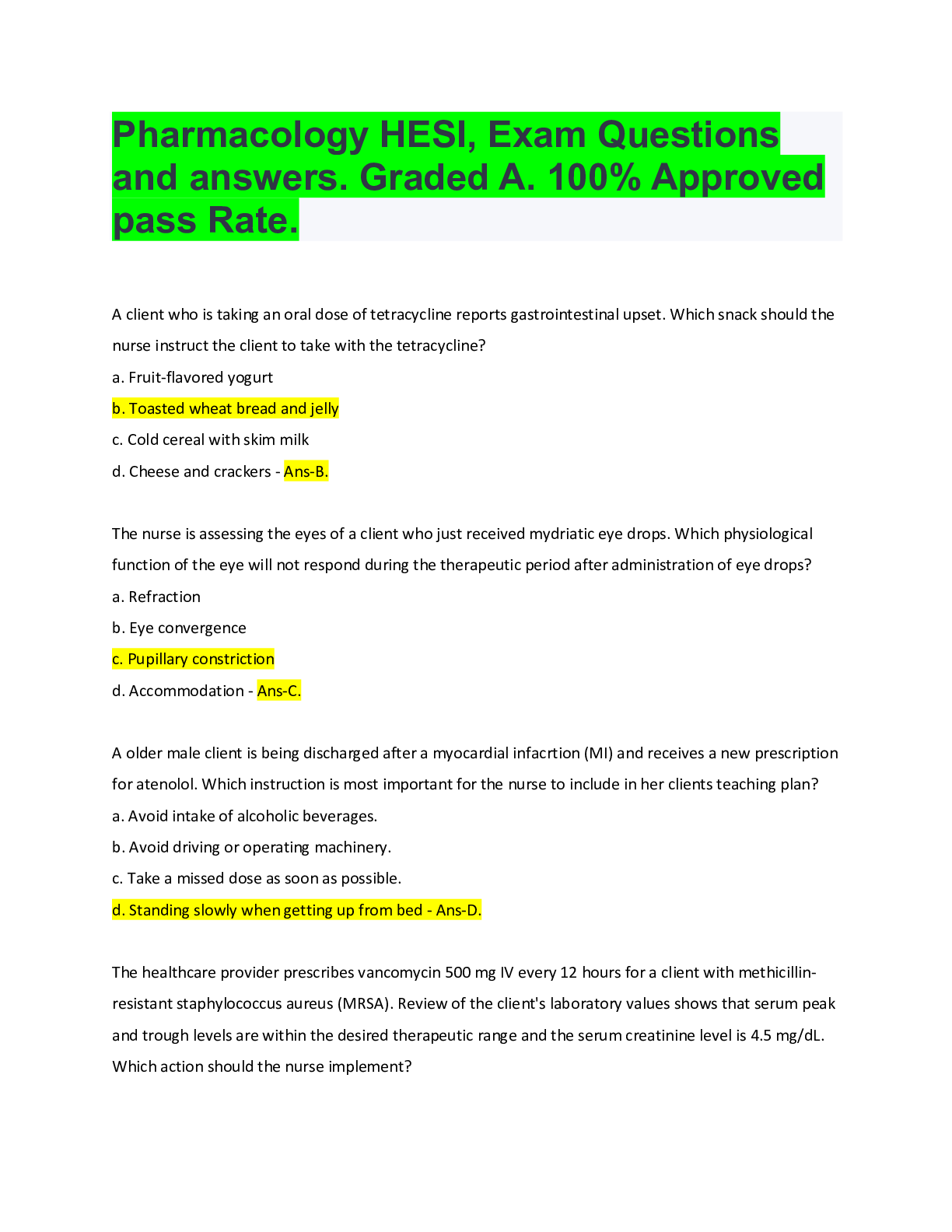
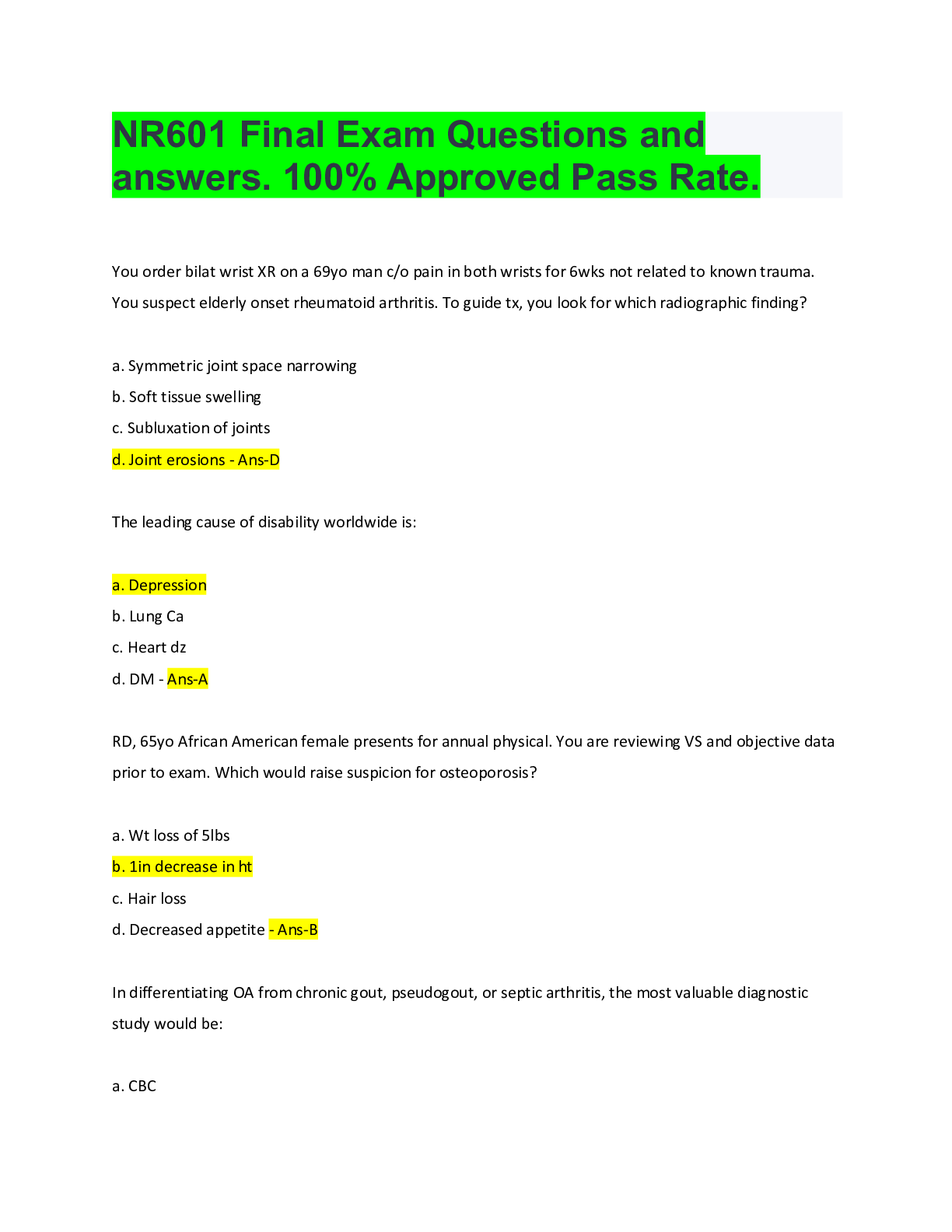
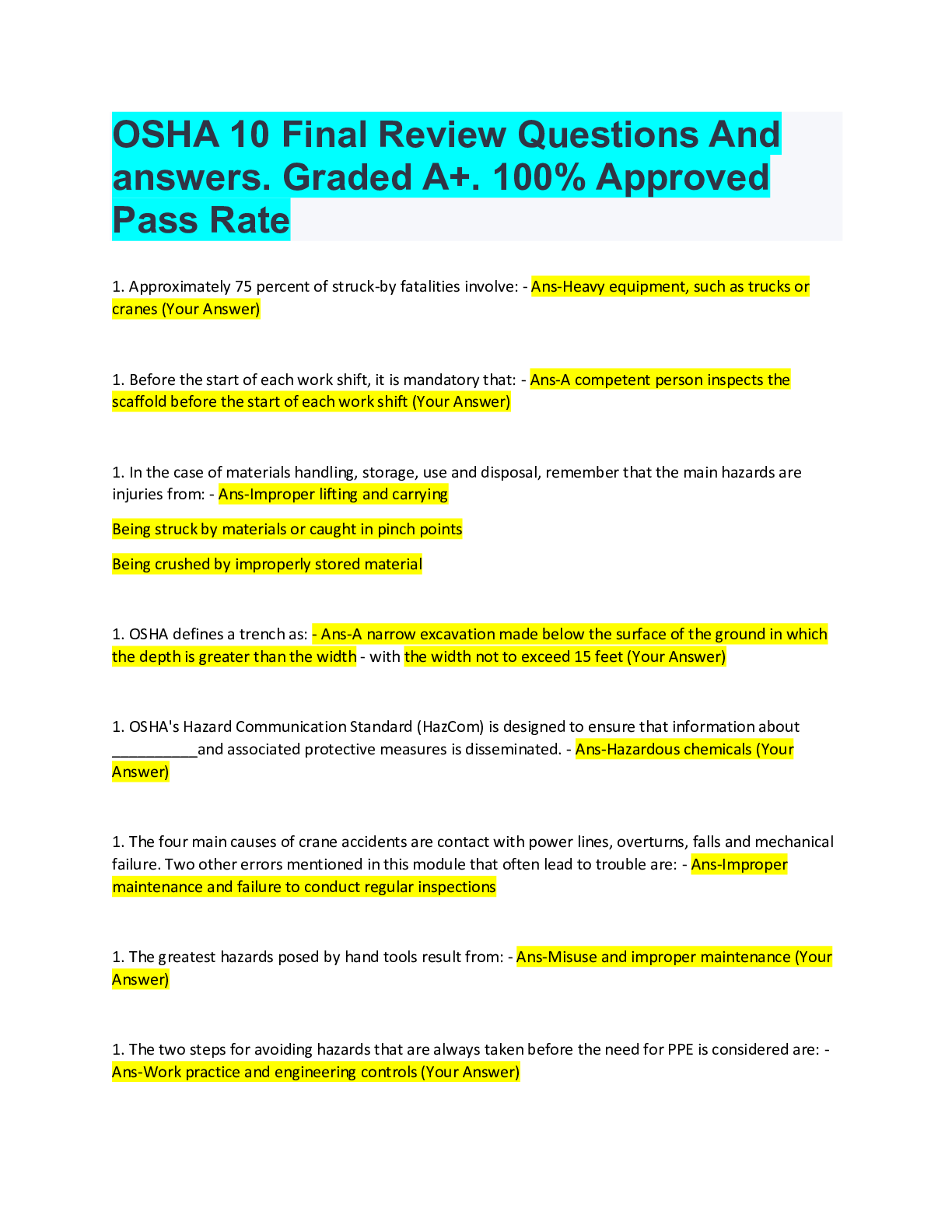
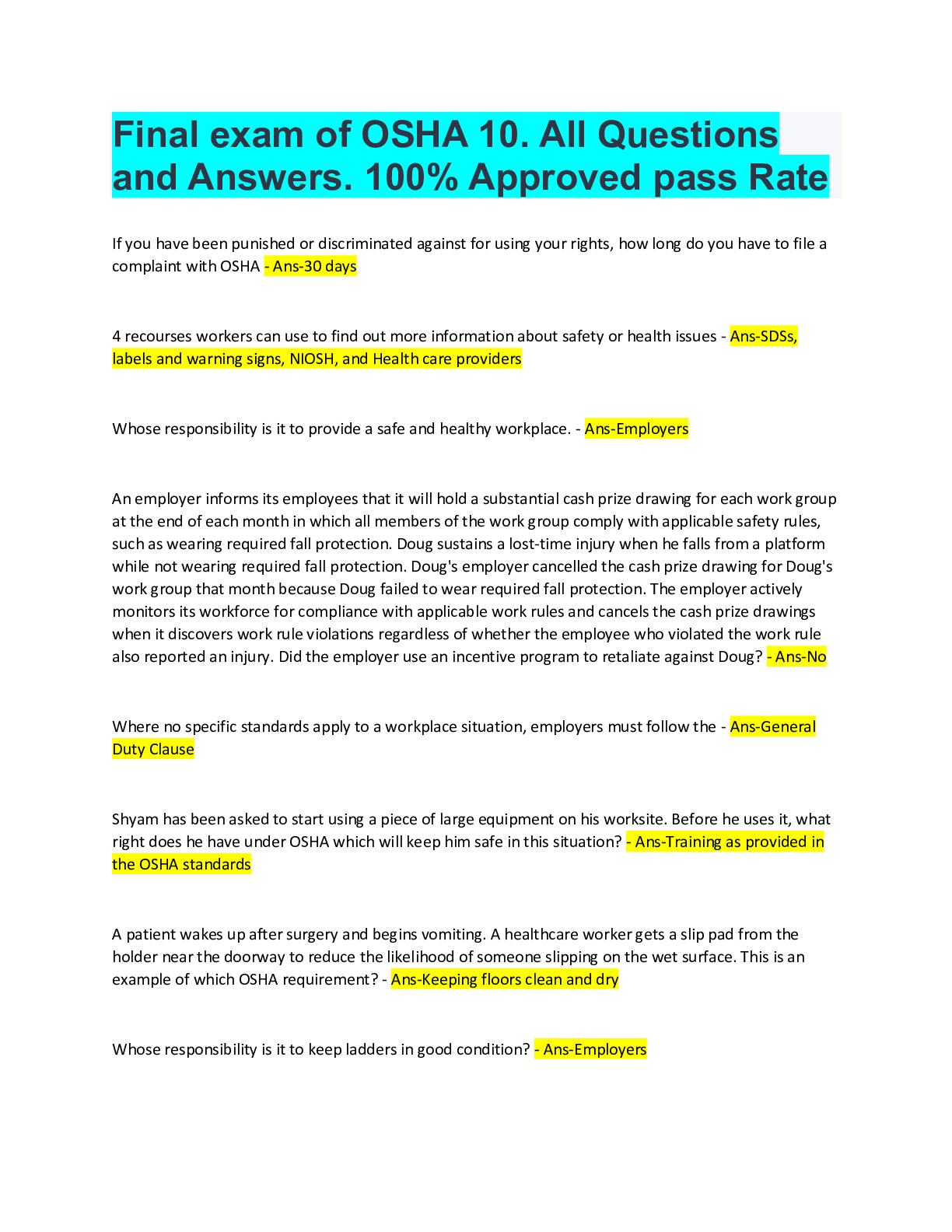

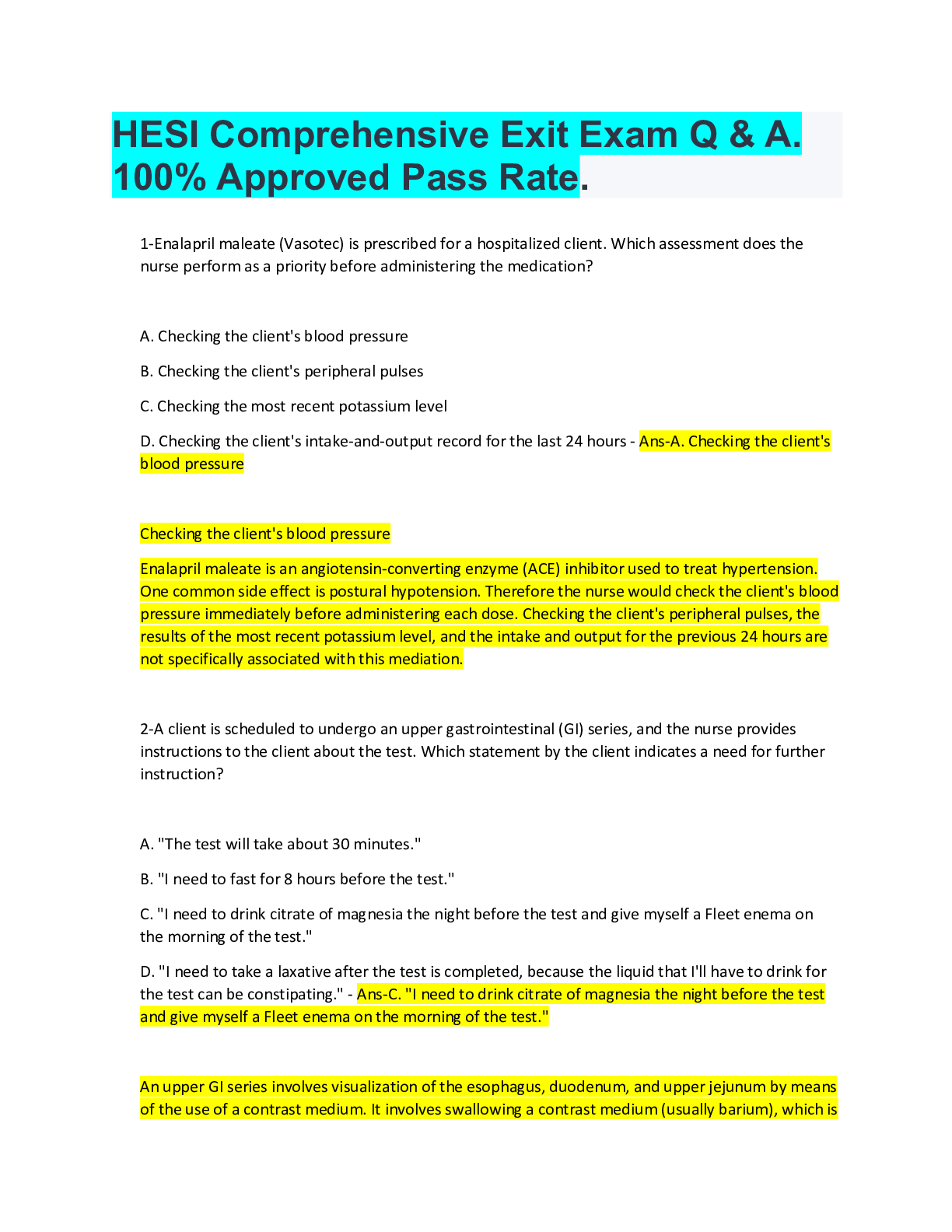

.png)
